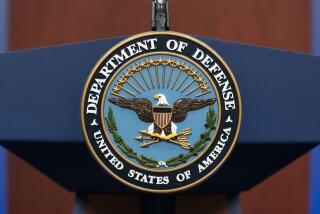Speaking Of: : THE GIs WHO STAYED BEHIND
- Share via
Not all of the roughly 540,000 American troops in Operation Desert Storm were able to go home after the fighting ended. More than 75,000 of remain in Turkey and the Persian Gulf area. That presence continues to shrink as more troops are sent back to their home bases, but some are expected to remain for a long time to come.
Here is a rundown on U.S. units still in the region, what they are doing there and how long they are expected to remain:
SOUTHEASTERN TURKEY AND NORTHERN IRAQ:
Who is there:
The countries in the allied coalition that helped to defeat Iraq still have about 17,000 troops in the region as part of “Operation Provide Comfort”--the code name for the 12-nation effort that began April 20 to provide a haven for Kurdish refugees. About 11,000 of those coalition troops are actually in northern Iraq.
About 8,500 Americans are part of Operation Provide Comfort, including roughly 4,300 soldiers, 3,300 airmen, 500 Navy personnel and 400 Marines. About half the Americans are deployed in southeastern Turkey and half in northern Iraq.
Another 4,585 U.S. service personnel are permanently stationed at about a dozen bases, listening posts and command centers in Turkey. About 2,300 of those are currently working in support of Operation Provide Comfort.
What they’re doing:
U.S. troops are providing security, food, shelter and medical care in northern Iraq. Some of them have been in Dahuk, an important Kurdish center, and other towns rebuilding and restoring electrical power and other essential services. The relief mission in Dahuk was completed over the weekend.).
As of today, 52 military personnel from the 12-nation coalition remain there, clearing explosives, completing the restoration of electrical power and providing other essential services.
Where they are:
In Turkey, there are major U.S. troop concentrations at Incirlik, Diyarbakir and Silopi, as well as at Izmir, the southeast headquarters of NATO. In Iraq, the U.S. headquarters is Zakhu. The easternmost location where U.S. troops are reported to be deployed is at Saddam Hussein’s old summer palace airstrip in Sirsenk.
How long they’ll stay:
Pentagon spokesman Pete Williams says there’s no way to know how long U.S. troops will be required to provide security and humanitarian assistance to the Kurds, although the plan is to turn over relief operations to the United Nations. U.S. officers say privately that with the exception of those personnel assigned to permanent bases in Turkey, the last soldiers may be gone from the area by the end of August.
KUWAIT CITY AND THE KUWAITI ‘THEATER’:
Who is there:
About 65,000 U.S. troops--including 20,000 reservists--remain stationed in the Kuwaiti Theater of Operations, which includes Kuwait, Bahrain, Saudi Arabia and ships in the Red Sea, Arabian Sea and the Persian Gulf. About 3,400 U.S. military personnel are in Kuwait city.
The breakdown for the theater includes 33,000 soldiers, 18,000 Navy personnel, 7,500 airmen, 6,000 Marines, and 350 others, including Defense Department military operations staff. There are 26 ships still assigned to the region--down from a high of more than 100 during the war.
What they’re doing:
The only combat unit in Kuwait is the 11th Armored Cavalry Regiment, which just arrived from Germany and last week replaced the 1st Brigade, 3rd Armored Division, camped in a sprawling warehouse complex at Doha, on a peninsula 10 miles northwest of Kuwait city. The mission of the unit’s 3,200 personnel is to provide security for the Kuwaiti government, which has agreed to pay for their upkeep.
Another key U.S. presence is the Defense Reconstruction Assistance Office, headquartered in Kuwait city and commanded by Maj. Gen. Patrick J. Kelly, who is the Department of Defense representative to the government of Kuwait. It has 50 staff members, about half of them civilian and half military, and is charged with helping the government rebuild.
Also, there are about 122 people with the Kuwait Emergency Recovery Office, under the Army Corps of Engineers--about 15 U.S. military personnel and 107 American civilians--plus Kuwaiti volunteers, mostly engineers and technicians. They are sizing up damage, estimating costs and managing bids and the contracting process. Right now, they are mostly working on power substations, sanitation, the airport radar system and some heavily damaged municipal buildings.
How long they’ll stay:
U.S. officials say no firm departure dates have been set, but they promise that virtually all of the reservists still in the region will be home by Nov. 1. Some active-duty troops will remain indefinitely to guard war stocks that are being left behind in the Gulf and to set up and staff a new central command forward headquarters--most likely in Abu Dhabi. The Navy will keep some ships in the Gulf and the northern Arabian Sea, as it has since 1948, but officials will not say how many.
The U.S. has made commitments to keep troops at Doha through Sept. 1. What happens after that is still unclear.
U.S. in ‘Operation Provide Comfort:’
TOTAL COALITION TROOPS: 17,000
U.S. SOLDIERS: 4,300
U.S. AIRMEN: 3,300
U.S. PERMANENT SUPPORT: 2,300
U.S. NAVY: 500
U.S. MARINES: 400
U.S. in Kuwaiti Theater
U.S. SOLDIERS: 33,000
U.S. NAVY: 18,000
U.S. AIRMEN: 7,500
U.S. MARINES: 6,000
OTHER U.S.: 350
THE COALITION AIDING REFUGEES:
United States
Britain
Germany
Luxembourg
Italy
Australia
Turkey
France
Netherlands
Canada
Spain
More to Read
Sign up for Essential California
The most important California stories and recommendations in your inbox every morning.
You may occasionally receive promotional content from the Los Angeles Times.










